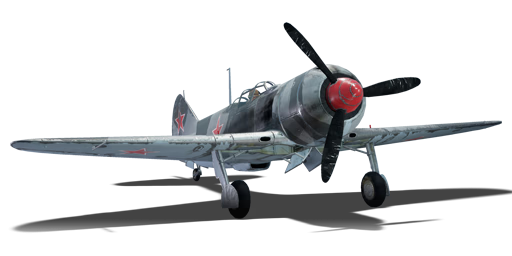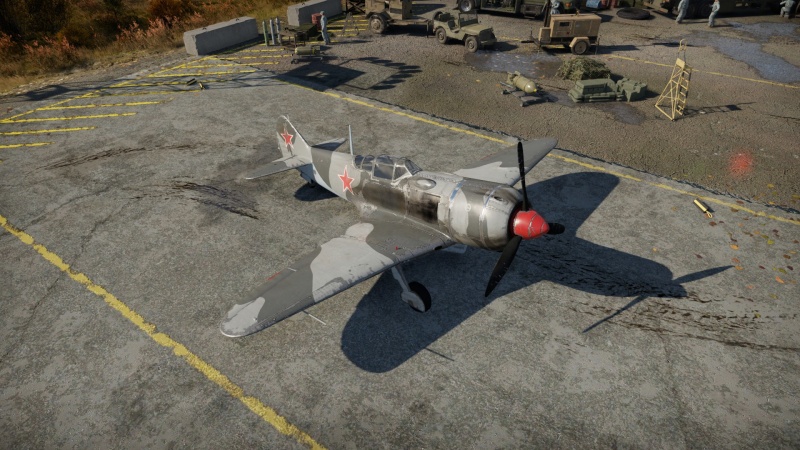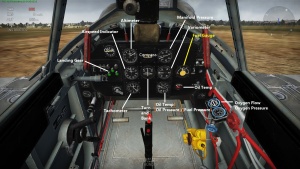Difference between revisions of "La-7"
(Updated format) |
|||
| Line 1: | Line 1: | ||
| − | |||
| − | |||
| − | |||
| − | |||
{{About | {{About | ||
| about = Russian fighter '''{{PAGENAME}}''' | | about = Russian fighter '''{{PAGENAME}}''' | ||
| Line 10: | Line 6: | ||
| usage-2 = the other version | | usage-2 = the other version | ||
| link-2 = La-7B-20 | | link-2 = La-7B-20 | ||
| + | }} | ||
| + | {{Specs-Card | ||
| + | |code=la-7 | ||
| + | |images={{Specs-Card-Image|GarageImage_{{PAGENAME}}.jpg}} | ||
}} | }} | ||
== Description == | == Description == | ||
<!-- ''In the description, the first part should be about the history of and the creation and combat usage of the aircraft, as well as its key features. In the second part, tell the reader about the aircraft in the game. Insert a screenshot of the vehicle, so that if the novice player does not remember the vehicle by name, he will immediately understand what kind of vehicle the article is talking about.'' --> | <!-- ''In the description, the first part should be about the history of and the creation and combat usage of the aircraft, as well as its key features. In the second part, tell the reader about the aircraft in the game. Insert a screenshot of the vehicle, so that if the novice player does not remember the vehicle by name, he will immediately understand what kind of vehicle the article is talking about.'' --> | ||
| − | |||
| − | |||
The '''{{Specs|name}}''' is a rank {{Specs|rank}} Russian fighter {{Battle-rating}}. This aircraft has been in the game since the start of the Open Beta Test prior to Update 1.27. | The '''{{Specs|name}}''' is a rank {{Specs|rank}} Russian fighter {{Battle-rating}}. This aircraft has been in the game since the start of the Open Beta Test prior to Update 1.27. | ||
| Line 92: | Line 90: | ||
! - | ! - | ||
|- | |- | ||
| − | |{{Specs|1=destruction|2=body}}||{{Specs|1=destruction|2=gear}} | + | |{{Specs|1=destruction|2=body}}||{{Specs|1=destruction|2=gear}} || 530 || ~13 || ~13 |
|- | |- | ||
|} | |} | ||
| Line 141: | Line 139: | ||
=== Modifications and economy === | === Modifications and economy === | ||
{{Specs-Economy}} | {{Specs-Economy}} | ||
| + | |||
| + | Four upgrades are of importance: ''Offensive 20 mm'', ''Compressor'', ''Engine'' and ''Engine injection''. | ||
== Armaments == | == Armaments == | ||
| Line 193: | Line 193: | ||
|- | |- | ||
|} | |} | ||
| − | |||
| − | |||
| − | |||
| − | |||
| − | |||
| − | |||
| − | |||
| − | |||
| − | |||
| − | |||
| − | |||
| − | |||
| − | |||
| − | |||
| − | |||
| − | |||
| − | |||
| − | |||
| − | |||
| − | |||
| − | |||
| − | |||
| − | |||
| − | |||
| − | |||
| − | |||
| − | |||
| − | |||
| − | |||
| − | |||
| − | |||
| − | |||
| − | |||
| − | |||
| − | |||
=== Pros and cons === | === Pros and cons === | ||
| Line 264: | Line 229: | ||
===In-game description=== | ===In-game description=== | ||
| − | The Lavochkin La-7 was a Soviet single-seat single-engine monoplane fighter. It was a further development of the La-5FN. The first prototype was built in January 1944, making its first flight on 2nd February and entering state trials on 16th February. The aircraft entered serial production in May 1944, designated La-7, and fully replaced the La-5FN on production lines by November 1944. | + | The Lavochkin La-7 was a Soviet single-seat single-engine monoplane fighter. It was a further development of the La-5FN. The first prototype was built in January 1944, making its first flight on 2nd February and entering state trials on 16th February. The aircraft entered serial production in May 1944, designated La-7, and fully replaced the La-5FN on production lines by November 1944. |
The La-7 was one of the best serial fighters of WWII, highly maneuverable with advanced performance characteristics and powerful armament. One on one, it was greatly superior to contemporary Axis, British and US fighters at low and medium altitudes. Other features included improved survivability and ease of control. A total of 5,735 La-7s were built before the end of WWII. | The La-7 was one of the best serial fighters of WWII, highly maneuverable with advanced performance characteristics and powerful armament. One on one, it was greatly superior to contemporary Axis, British and US fighters at low and medium altitudes. Other features included improved survivability and ease of control. A total of 5,735 La-7s were built before the end of WWII. | ||
| Line 270: | Line 235: | ||
=== Notable pilots === | === Notable pilots === | ||
| − | <div><ul> | + | <div><ul> |
<li style="display: inline-block;"> [[File:Ivan_Kozhedub_2.jpg|thumb|none|200px|link=User:U64962917#Kozhedub,_Ivan_N.|Soviet ace pilot [[User:U64962917#Kozhedub,_Ivan_N.|Ivan Kozhedub]], highest scoring Allied ace of WW II.]] </li><!-- | <li style="display: inline-block;"> [[File:Ivan_Kozhedub_2.jpg|thumb|none|200px|link=User:U64962917#Kozhedub,_Ivan_N.|Soviet ace pilot [[User:U64962917#Kozhedub,_Ivan_N.|Ivan Kozhedub]], highest scoring Allied ace of WW II.]] </li><!-- | ||
<li style="display: inline-block;"> [[File:X.jpg|thumb|none|250px|"Image Description"]] </li> | <li style="display: inline-block;"> [[File:X.jpg|thumb|none|250px|"Image Description"]] </li> | ||
Revision as of 21:43, 29 December 2020
| This page is about the Russian fighter La-7. For the premium version, see Dolgushin's La-7. For the other version, see La-7B-20. |
Contents
Description
The La-7 is a rank III Russian fighter with a battle rating of 4.3 (AB), 4.7 (RB), and 5.0 (SB). This aircraft has been in the game since the start of the Open Beta Test prior to Update 1.27.
The La-7 is an effective mid-low altitude interceptor. It has many unique capabilities that make it an exceptional fighter. As the successor of the La-5/F/FN, it has a more powerful engine and improved aerodynamics.
General info
Flight performance
Describe how the aircraft behaves in the air. Speed, manoeuvrability, acceleration and allowable loads - these are the most important characteristics of the vehicle.
| Characteristics | |||||||
|---|---|---|---|---|---|---|---|
| Stock | |||||||
| Max Speed (km/h at 6,250 m) |
Max altitude (meters) |
Turn time (seconds) |
Rate of climb (meters/second) |
Take-off run (meters) | |||
| AB | RB | AB | RB | AB | RB | ||
| 651 | 631 | 10450 | 20.0 | 20.6 | 14 | 14 | 348 |
| Upgraded | |||||||
| Max Speed (km/h at 6,250 m) |
Max altitude (meters) |
Turn time (seconds) |
Rate of climb (meters/second) |
Take-off run (meters) | |||
| AB | RB | AB | RB | AB | RB | ||
| 711 | 677 | 10450 | 18.3 | 19.2 | 23.9 | 18.2 | 348 |
Details
| Features | ||||
|---|---|---|---|---|
| Combat flaps | Take-off flaps | Landing flaps | Air brakes | Arrestor gear |
| ✓ | ✓ | ✓ | X | X |
| Limits | ||||
|---|---|---|---|---|
| Wing-break speed (km/h) |
Gear limit (km/h) |
Combat flaps (km/h) |
Max Static G | |
| + | - | |||
| 735 | 320 | 530 | ~13 | ~13 |
| Optimal velocities | |||
|---|---|---|---|
| Ailerons (km/h) |
Rudder (km/h) |
Elevators (km/h) |
Radiator (km/h) |
| < 400 | < 400 | < 400 | > 341 |
| Compressor (RB/SB) | ||
|---|---|---|
| Setting 1 | ||
| Optimal altitude | 100% Engine power | WEP Engine power |
| 1,550 m | 1,630 hp | 1,920 hp |
| Setting 2 | ||
| Optimal altitude | 100% Engine power | WEP Engine power |
| 4,550 m | 1,430 hp | N/A |
Survivability and armour
- 8.5 mm Steel - Armor plate behind pilot's seat (with upgrade = 10 mm total)
- 55 mm Bulletproof Glass - Fore canopy
- 66 mm Bulletproof Glass - Rear canopy/headrest (with upgrade = 75 mm total)
Modifications and economy
Four upgrades are of importance: Offensive 20 mm, Compressor, Engine and Engine injection.
Armaments
Offensive armament
The La-7 is armed with:
- 2 x 20 mm ShVAK cannons, nose-mounted (170 rpg = 340 total)
Suspended armament
The La-7 can be outfitted with the following ordnance:
- Without load
- 2 x 50 kg FAB-50 bombs (100 kg total)
- 2 x 100 kg FAB-100 bombs (200 kg total)
Usage in battles
The key to staying alive in the La-7 series lies in using evasion and deception to destroy the enemy. Start by flying at around 4.5 km altitude as you present yourself as an easy target for Boom & Zoom aircraft that are flying at higher altitudes. Maintain a high energy level/speed (conserve your energy as well). When you spot someone diving at you, break off and evade his burst, and then chase him and return your own bursts, or, if he turns, engage in turning combat. Watch your opponent, however. Spitfire (Griffons) can, for the most part, out-turn a La-7 while other planes such as the Fw 190 D are far inferior at turning. It is possible to force overshoots on Spitfires by going into scissors. Acceleration on this plane is excellent at low-medium altitude (below 3 km where WEP still works). Additionally, the La-7 can be an effective mid-alt Boom and Zoom / energy fighter - when most opponents have been destroyed and the rest are engaging below you, the La-7, with its effective climb rate as well as acceleration/energy retention, can be unstoppable.
One habit you have to take to heart is aiming strategies/skill. The 2 cowling-mounted ShVAKs are quite ineffective in side-on approaches as well as longer range fire due to the fact that there is little spread to the cannons and low damage and hit detection compared to comparable 20 mm cannons such as the Hispano and MG-151. The low spread allows for greater damage upon hitting your opponent - if used correctly, the cannons can be extremely lethal. Ground Targets belts have the most HE shells in their composition; these are the most versatile as they are extremely effective against planes as well as Ground targets.
Another habit worth developing in the La-7 is ammo conservation, it is crucial to only take shots that you know will hit and aiming them carefully. This way you stand a bigger chance of critically damaging the enemy aeroplane. By following those rules you will soon find yourself researching the final Lavochkin piston fighter - the La-9.
The aircraft is placed quite low in the Battle Rating spread, which means that you will still engage rank III aircraft. Do not underestimate them. If flown up to their respective strengths, planes such as the Bf 109 G-2 and Spitfire Mk Vc are superior to the La-7. The strengths of both La-7 variants lie in very good low altitude performance - ideally, you want to engage your enemies at altitudes lower than 5 km - higher up, the power output of the engine reduces drastically, making you an easy target. Aside from the speed, the La-7 possesses very good turning capabilities - while it is not as good a turner as some British and Japanese designs, it can give many German and US aircraft a run for their money.
Manual Engine Control
| MEC elements | ||||||
|---|---|---|---|---|---|---|
| Mixer | Pitch | Radiator | Supercharger | Turbocharger | ||
| Oil | Water | Type | ||||
| Not controllable | Controllable Not auto controlled |
Controllable Not auto controlled |
Controllable Not auto controlled |
Separate | Controllable 2 gears |
Not controllable |
Pros and cons
Pros:
- Excellent low altitude performance (< 3,000 m / 9,843 ft)
- Decent manoeuvrability
- Great acceleration and rate of climb
- Good roll rate
- Center-mounted cannons - can be a blessing or a curse, depending on your aiming ability
- Decent cockpit visibility
- Good speed in level flight
- Pilot armour options
- Bomb options
- has less of a stock syndrome than most other tier IV aircraft
Cons:
- Poor performance at high altitude (> 4,000 m / 13,124 ft)
- Poor maximum dive speed
- Fast-firing cannons means you have to be more diligent with ammo conservation
- Tends to bleed energy
- Center-mounted cannons can be difficult to master
- Poor stock belts
- Relatively poor durability - wings tend to rip at higher speeds compared to contemporaries
- Jack-of-all trades fighter - no specialized job means that the La-7 isn't optimised for tasks like Boom & Zoom
History
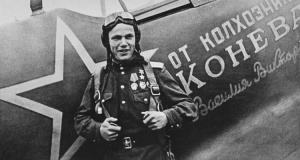
The concept of a new fighter for the Soviet Air Force was pitched in 1943. While the earlier Lavochkin La-5 proved to be one of the best Soviet fighters produced up to that point, the main designer of the La-5, Semyon Lavochkin, felt that it could be improved even further. Work on a completely new fighter began in the early months of 1944. The new fighter was supposed to be an improved version of the La-5 design. The changes included the incorporation of a lighter and more durable metal airframe in place of the earlier wooden one. Other changes included the mounting of a new gun sight and propeller, as well as the strengthening of the landing gear struts and streamlining of the wings. It was to be armed with three Berezin B-20 20 mm cannons, however, the delay in production meant that most new La-7s were armed with 2 x 20 mm ShVAK cannons, like its predecessor. After more tests, the new fighter was accepted into serial production in late 1944.
In September 1944, the first La-7s found their way onto the front lines with the 63rd Guard Fighter Aviation Corps. The reception of the new fighter was warm - it was faster and more manoeuvrable than the La-5, which meant it could more efficiently tackle the most common German fighter the Soviets faced: the Messerschmitt Bf 109 G. In certain circumstances, the speed allowed the Soviet pilots to intercept Fw 190 fighter-bombers - a feat impossible to achieve for other Soviet fighters like the Yak-3. The main critiques of the design were considered to be the engine reliability and armament - the twin 20 mm ShVAK cannons were judged as inadequate in fights against better armoured Fw 190s. Still, the La-7 became one of the most successful Soviet piston fighters of World War II. Soviet ace Ivan Kozhedub scored 17 kills while flying the La-7 - his last one being an Me 262 jet. After the war, the La-7 was replaced by the La-9 prop fighter, although many were still used by other communist states as both fighters and trainer aircraft.
In-game description
The Lavochkin La-7 was a Soviet single-seat single-engine monoplane fighter. It was a further development of the La-5FN. The first prototype was built in January 1944, making its first flight on 2nd February and entering state trials on 16th February. The aircraft entered serial production in May 1944, designated La-7, and fully replaced the La-5FN on production lines by November 1944.
The La-7 was one of the best serial fighters of WWII, highly maneuverable with advanced performance characteristics and powerful armament. One on one, it was greatly superior to contemporary Axis, British and US fighters at low and medium altitudes. Other features included improved survivability and ease of control. A total of 5,735 La-7s were built before the end of WWII.
Notable pilots
-
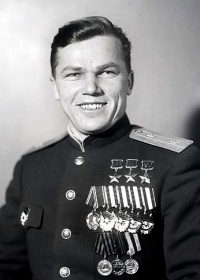 Soviet ace pilot Ivan Kozhedub, highest scoring Allied ace of WW II.
Soviet ace pilot Ivan Kozhedub, highest scoring Allied ace of WW II.
Media
See also
External links
Paste links to sources and external resources, such as:
- topic on the official game forum;
- encyclopedia page on the aircraft;
- other literature.
| Lavochkin Design Bureau (Лавочкинa Опытное конструкторское бюро) | |
|---|---|
| LaGG-3* | I-301 · LaGG-3-4 · LaGG-3-8 · LaGG-3-11 · LaGG-3-23 · LaGG-3-34 · LaGG-3-35 · LaGG-3-66 |
| La-5/7 | La-5 · La-5F · La-5FN · La-7 · Dolgushin's La-7 · La-7B-20 |
| La-9/11 | La-9 · La-11 |
| Jet Fighters | La-15 · La-174 · La-200 |
| Export | ␗La-9 · ␗La-11 |
| Captured | ▀La-5FN |
| *Lavochkin-Gorbunov-Gudkov (Лавочкин-Горбунов-Гудков), head designer V. P. Gorbunov | |
| USSR fighters | |
|---|---|
| I-15 | I-15 WR · I-15 M-22 · I-15 M-25 · I-15bis · Krasnolutsky's I-15bis |
| I-153 M-62 · Zhukovsky's I-153-M62 · I-153P | |
| I-16 | I-16 type 5 · I-16 type 10 · I-16 type 18 · I-16 type 24 · I-16 type 27 · I-16 type 28 · I-180S |
| I-29 | I-29 |
| I-185 | I-185 (M-71) · I-185 (M-82) |
| I-225 | I-225 |
| ITP | ITP (M-1) |
| MiG-3 | MiG-3-15 · MiG-3-15 (BK) · MiG-3-34 |
| LaGG | I-301 · LaGG-3-4 · LaGG-3-8 · LaGG-3-11 · LaGG-3-23 · LaGG-3-34 · LaGG-3-35 · LaGG-3-66 |
| La | La-5 · La-5F · La-5FN · La-7 · Dolgushin's La-7 · La-7B-20 · La-9 · La-11 |
| Yak-1/7 | Yak-1 · Yak-1B · Yak-7B |
| Yak-3 | Yak-3 · Eremin's Yak-3(e) · Yak-3P · Yak-3T · Yak-3U · Yak-3 (VK-107) |
| Yak-9 | Yak-9 · Yak-9B · Golovachev's Yak-9M · Yak-9T · Yak-9K · Yak-9U · Yak-9UT · Yak-9P |
| Other countries | ▂P-40E-1 · ▂P-47D-27 · ▂Hurricane Mk IIB · ▂Fw 190 D-9 · ▂Spitfire Mk IXc |
| P-39 | ▂P-39K-1 · ▂Pokryshkin's P-39N-0 · ▂P-39Q-15 |
| P-63 | ▂P-63A-5 · ▂P-63A-10 · ▂P-63C-5 |


